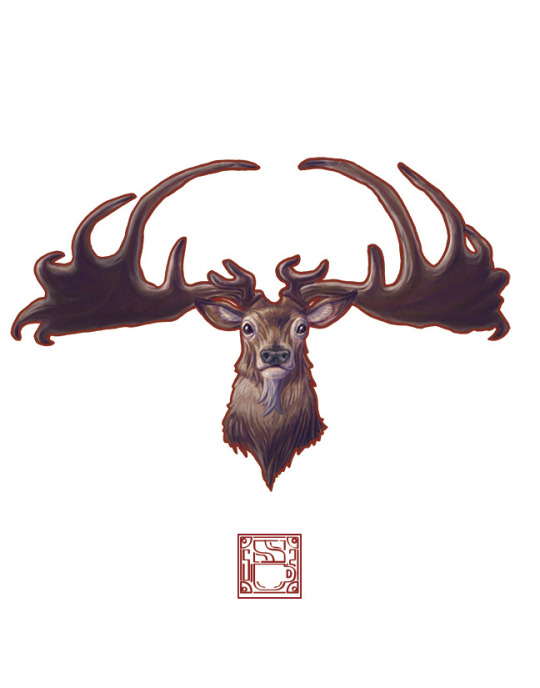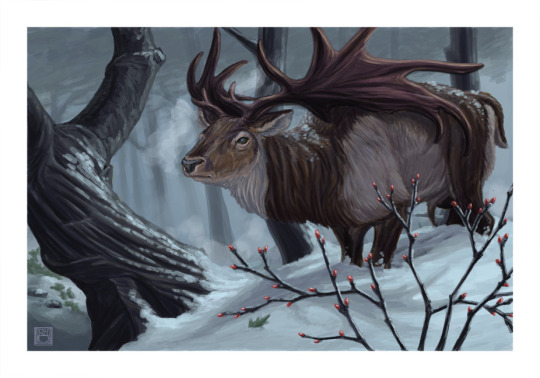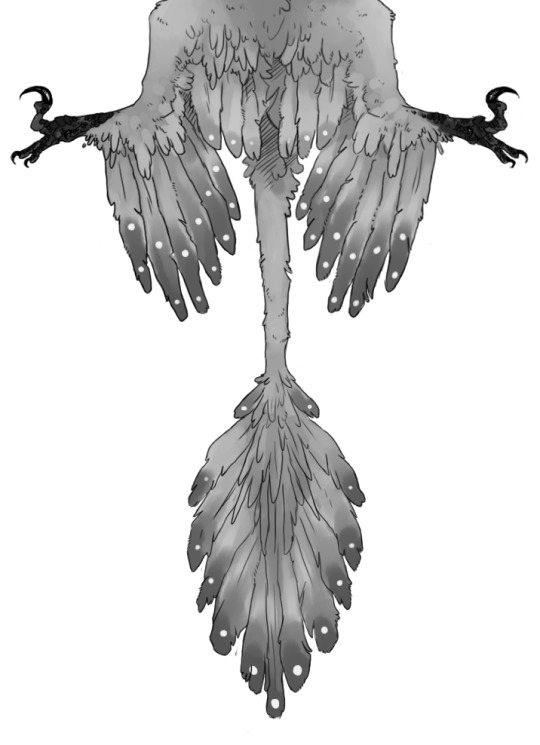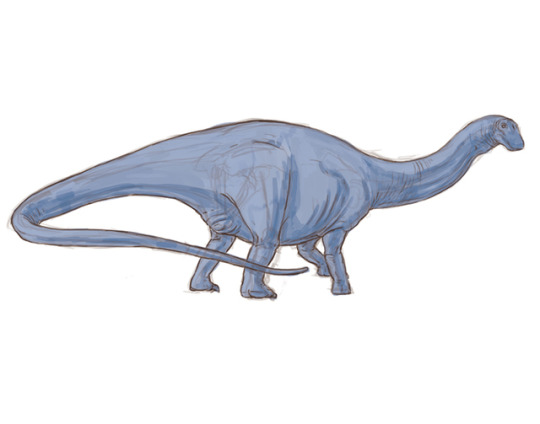#paleonotology
Text
It's St. Patricks Day! So here is a couple of Megaloceros pieces to help us all remember a time when giants roamed the misty glens and boglands of Ireland.


#stpatricksday#saintpatricksday#megaloceros#irishelk#ireland#paleonotology#paleoart#sciart#science#digitalart#digital illustration#art#paleo#ice age#artistsontumblr
996 notes
·
View notes
Photo

Go to School
This remarkable figure was just published in a paper in the Journal “Proceedings of the Royal Society”. It shows a surface in the Green River Formation – an Eocene aged deposit found largely in Wyoming, Colorado, and Utah. During the Eocene, this part of the country was filled by a series of lakes surrounded by higher peaks of the Rocky Mountains. When there was enough water, these lakes grew, but during drier periods the lakes contracted and became saltier, often killing fish and other organisms living in the water. Because the water was too salty for any scavengers to come along and eat the bodies, these fish fossils are often remarkably well preserved, even containing remnants of the skin and scales.
This particular slab is about half a meter long and it contains a whopping 259 separate fossilized fish. It was recently characterized by scientists from Arizona State University, who argued that this represents a school of fish.
It is unknown when fish began grouping together into schools and it is often difficult to find evidence of behavior trapped in the fossil record, so identifying a true school of fish in 50-million-year-old rocks would verify that behavior was common at least that far back in the Earth’s history. While these fish are all found together, that doesn’t verify that they were a true school while they were alive – they could have been aligned by currents after they were killed.
The other parts of this figure show the additional work the scientists did – they characterized the spacing between organisms and variation in the direction that the fish were facing to see if they matched modern schooling behavior. In this case, the scientists argue that the arrangement does match modern behavior – each fish has about the amount of space they would have had if this was a school of fish swimming together. Therefore, they argue that this deposit is in fact recording an Eocene-aged school of fish.
However, there are a few uncertainties – specifically the taphonomy, or the process of fossilization of this outcrop. In other words, how exactly did these fish die and how were they buried? For the fish to actually preserve the spacing they were swimming with, the school would have had to all die instantly and then be buried immediately. There is no evidence of a rapid event recorded in the available sediment, but there is also no evidence of a strong current flowing that could have aligned these fish after they died. The hypothesis of schooling behavior is supported by this find, but without knowing what killed the fish, part of the story remains missing.
-JBB
Image credit and original paper: https://royalsocietypublishing.org/doi/10.1098/rspb.2019.0891
#science#fossil#fossils#fish#fossilfriday#eocene#school#behavior#paleonotology#green river formation#the earth story#taphonomy
49 notes
·
View notes
Photo

🟡 OTTOBRE È UN MESE MERAVIGLIOSO, A ROVERETO! In questi giorni il RAM Film Festival offre uno squisito programma di proiezioni a tema archeologico, storico, paleonotologico e antropologico, come di esperienze diffuse nei quartieri della nostra città. Palazzo Betta-Grillo in Santa Maria è aperto per voi questo sabato 16 ottobre, all'interno della programmazione RAM, in collaborazione con Touring Club. Sempre sabato il trekking urbano di Visitrovereto vi porta da Santa Maria lungo tutto il chilometro delle meraviglie. Il Museo della Città e il Museo Storico Italiano della Guerra aprono le proprie porte sul Leno con diversi appuntamenti. Info: https://www.rassegnacinemaarcheologico.it/rica_context.jsp?ID_LINK=115152&area=316 In sintonia con il nostro recente laboratorio olfattivo condotto da Marco Ceravolo, l'interesse per l'ofatto informa il percorso odoroso legato alla civetta portaessenze Askos di Paolo Orsi. Info: https://www.osvaldomaffei.com/osvaldo-new-osvaldo/ 🟡 OCTOBER IS A WONDERFUL MONTH IN ROVERETO! These days the RAM Film Festival offers an exquisite programme of screenings on archaeological, historical, paleonotological and anthropological themes, as well as widespread experiences in the neighbourhoods of our city. Palazzo Betta-Grillo in Santa Maria is open for you this Saturday 16 October, as part of the RAM programme, in collaboration with Touring Club. Also on Saturday, Visitrovereto's urban trekking takes you from Santa Maria along the kilometre of wonders. The City Museum and the Italian War History Museum open their doors on the Leno with various appointments. In tune with our recent olfactory workshop led by Marco Ceravolo, the interest in the ophatto informs the odour path linked to Paolo Orsi's Askos owl fragrance holder. #santamariadistrettorovereto #vallagarina #visitvallarsa #visitrovereto #visitvallagarina #rigenerazioneurbana #rigenerarovereto #giallo #distrettogiallo #yellow #yellowdistrict #distrettosantamaria #santamariadistrict #roveretoincentro #comunedirovereto #bettagrillo #distrettosanmarco #roveretodowntown #distrettocultura #distrettodellaquercia #ramfestival #touringclubtrentino #archeologia (presso Via Santa Maria) https://www.instagram.com/p/CU_01xKjplK/?utm_medium=tumblr
#santamariadistrettorovereto#vallagarina#visitvallarsa#visitrovereto#visitvallagarina#rigenerazioneurbana#rigenerarovereto#giallo#distrettogiallo#yellow#yellowdistrict#distrettosantamaria#santamariadistrict#roveretoincentro#comunedirovereto#bettagrillo#distrettosanmarco#roveretodowntown#distrettocultura#distrettodellaquercia#ramfestival#touringclubtrentino#archeologia
0 notes
Video
youtube
Cava Bomba - Museo Geo-Paleontologico a Padova - Discover Italy
0 notes
Photo


Microraptor closeups! the photoset makes it look like it has giant clown legs oops
134 notes
·
View notes
Photo

Getting the basic color and patterning set up on the work in progress for my Cretaceous Traffic Jam illustration featuring Troodon formosus and Pachyrhinosaurus canadensis. Color is pulling from a Great Horned Owl on and a bit of a Greater Short-Horned Lizard. Troodon will be drawn from an Eastern Downy Woodpecker.
#workinprogress#illustration#wip#troodon#pachyrhinosaurus#cretaceous#dinosaur#dinosaurart#dino#dinoart#paleonotology#paleo#paleoart#sciart#science#educational#naturalhistory#ceratopsian#troodontid#digitalart#digitalillustration#illustrationart#art#artist#maine#maineart#newengland#newenglandart#artistsontumblr
33 notes
·
View notes
Photo

Work in progress underpainting for Brontosaurus excelsus! First named in 1879 by O.C. Marsh, Brontosaurus (meaning "Thunder Lizard") was a mainstay of the public's vision of prehistoric life for more than 100 years, and is the archetype for what most people think of when they conjure up images of sauropod dinosaurs.
The history of it's discovery and classification is somewhat complicated. The original remains were discovered at Como Bluff in Wyoming, in 1903 a paleontologist named Elmer Riggs posed an argument that Marsh's Brontosaurus was not significantly distinguishable from another sauropod described by Marsh just 2 years prior which had been dubbed Apatosaurus, this started a debate as to whether the two animals were really the same animal or not.
Despite the possibility that it wasn't a new animal the American Museum of Natural History chose to mount its skeleton and reveal it to the world as Brontosaurus in 1905. The initial mounted specimen was incomplete and was mounted with a sculpted skull based on Camarasaurus, giving it a head that was very large a thick compared to the much more slender, Diplodicocus-like skulls we now know they had, in 1909 a skull for Apatosaurus was discovered that showed the more slender skull to be more accurate for this type of animal, this did not spark change right away as most museum mountings still used the Camarasaurus skull for many decades.
In the 1970s John Stanton McIntosh and David Berman re-described the skulls for Diplodicus and Apatosaurus, though it had been suspected that Brontosaurus and its relatives had thin skulls since the early 20th century, it wasn't until 1979 when the first mounting of a more correct Apatosaurus skull was mounted, and it wasn't until the 1990s when most other museums followed suit.
In 1995 it was the American Museum of Natural History that finally corrected it's original mistake and not only fixed the skull and other parts of the anatomy, but also renamed the mounting from Brontosaurus excelsus to Apatosaurus excelsus.
While noted paleontologist Robert T. Bakker did argue in the 1990s that A. ajax and the newly renamed A. excelus were different enough to be classified as different genera, it wasn't until 2015 when a new study changed Brontosaurus back from being one of paleontology's biggest mistakes and reclassified it as a separate genus, though there is still much debate and criticism of the way the press covered the study, with many scientists suggesting that saying Brontosaurus is back is premature.
Whew, that was a weighty history, even though I did edit it down. Still, I chose to name this as a portrayal of Brontosaurus excelsus because I have always been a fan of the classics and because that seems to be where the most current science is leaning.
#workinprogress#wip#brontosaurus#sauropod#thunderlizard#dinosaur#jurassic#paleo#paleoart#paleonotology#sciart#science#educational#naturalhistory#digitalar#digitalillustration#illustration#illustrationartists#artist#paint#drawing#maine#maineart#newengland#artistsontumblr
26 notes
·
View notes
Video
youtube
The Palaeontological Association 58th Annual Meeting
Live! Right now! You can't tell by the preview, but the presentations are going out now from Annual meeting, held this year at the University of Leeds.
Found this via the Paleocast podcast (schedule is posted)website.
0 notes
Link
Postgraduate opportunities in palæontology in the UK. Not for me, but someone might use this...
4 notes
·
View notes